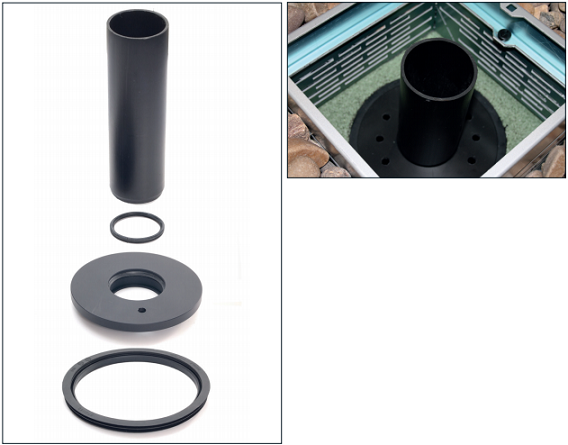Waterproofing system selection and outlets
Consideration must be given to the appropriate form of waterproofing so that it can meet the demands placed on it by the blue roof, as such performance characteristics for durability and thickness of membrane (density), tensile strength (EN 12311-1) and elongation at break (EN 12311- 1) need evaluation before appropriate selection can be made. The system should have the correct structural capacity to resist the dead load of the required finishes and any imposed loading produced by maintenance or emergency vehicles or other elements.
If the blue roof construction has a finish where germination of any plant seedlings is possible the membrane should be tested and approved to the current FLL and Green Roof Organisation (GRO) guidelines.
Our blue roof solutions utilise two robust waterproofing constructions; a bituminous warm or cold roof build-up with the Bauder Total Roof System (Green for soft landscaping) or a Bauder Hot Melt cold roof construction. Both systems carry BBA certification and are suitable to maintain the integrity required for blue and green roof applications.
Insulation within a waterproofing system
Warm roof construction with Bauder Total (Green) Roof System - The thermal effectiveness of the roof will not be impacted by the blue roof, but it is critical that the compressive strength of the insulation must exceed the maximum expected imposed loads for maximum height (H-Max) of the water within the blue roof element and the saturated weight of the roof finish.
Cold roof construction with Bauder Total Roof System or Bauder Hot Melt - The thermal effectiveness of the construction will have been included within the building rather than included in the waterproofing system.
Inverted Roofs - Bauder does not offer an inverted blue roof system as it is highly unlikely that an inverted blue roof will achieve the U-Value required by building regulations.
Deflections within a concrete slab often lead to ponding on the roof, with outlets being positioned close to walls or pillars. As the insulation is fully encapsulated within a warm roof build up, this ponding does not lead to any loss of thermal performance/U Value. In a normal inverted system an allowance is made for a small amount of trapped water; however, these calculations do not assume any deflections. Under storm conditions the restricted flow of the outlet will create pressure, and force water both beneath and in-between insulating layers, and thus causing some loss of thermal performance and runs the risk of flotation.
Outlets
The design of every blue roof is individual to the geographical location, construction project and the total allowable discharge defined by the LPA within the planning approval.
The calculations for drainage requirements are a specialist discipline and should only be carried out by a qualified professional. Bauder produces roof specific discharge reports for the blue roof specifications we are engaged with.
Blue roof outlets should have easily accessible inspection chambers fitted for regular maintenance to ensure the outlet is free from blockages.
Restrictor Outlets
The design, manufacture and installation of a flow restrictor and outlet is critical to the success of a blue roof as the outlet will be subjected to greater water pressures than standard gravity-fed drainage and it could be immersed for longer periods.
The flow restrictor component should be manufactured with an integral flange of the waterproofing membrane to enable a homogenous seal to be achieved. The connection between the outlet spigot and down pipe must be sealed and secure.
Emergency Overflows
Emergency drainage will be provided with the primary outlet and a secondary method of drainage to facilitate the removal of excess rainfall if the designed capacity is exceeded.
The emergency overflow outlet will be specified and the base of the overflow pipe should be placed level with the top of the void height or H-Max.
Maintenance access is important to allow for clearing of any silt, debris, or leaf and plant matter which could block or restrict the flow of water through the emergency outlet. This is particularly important if trees are located nearby, as they can be a frequent source of material.
